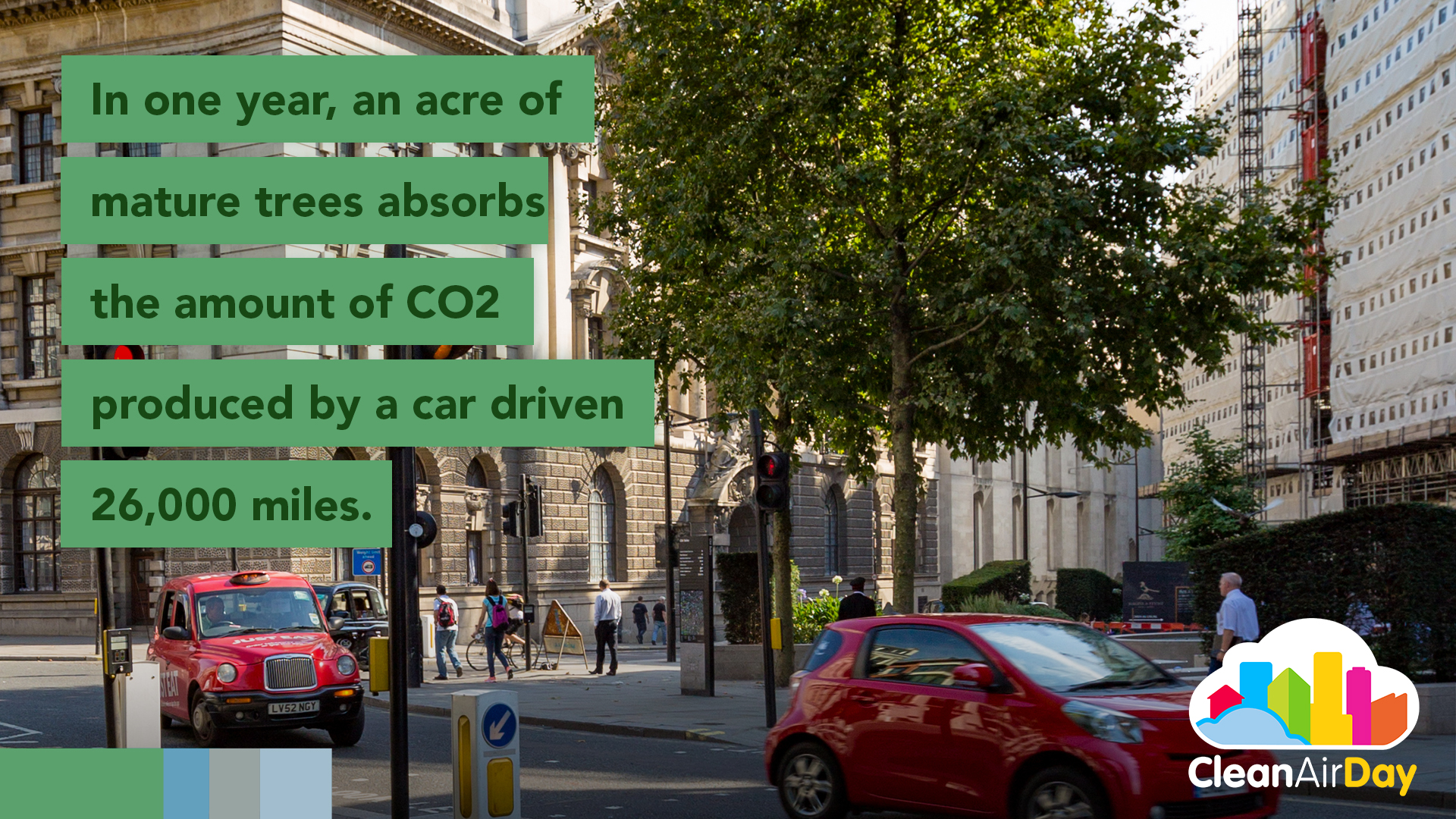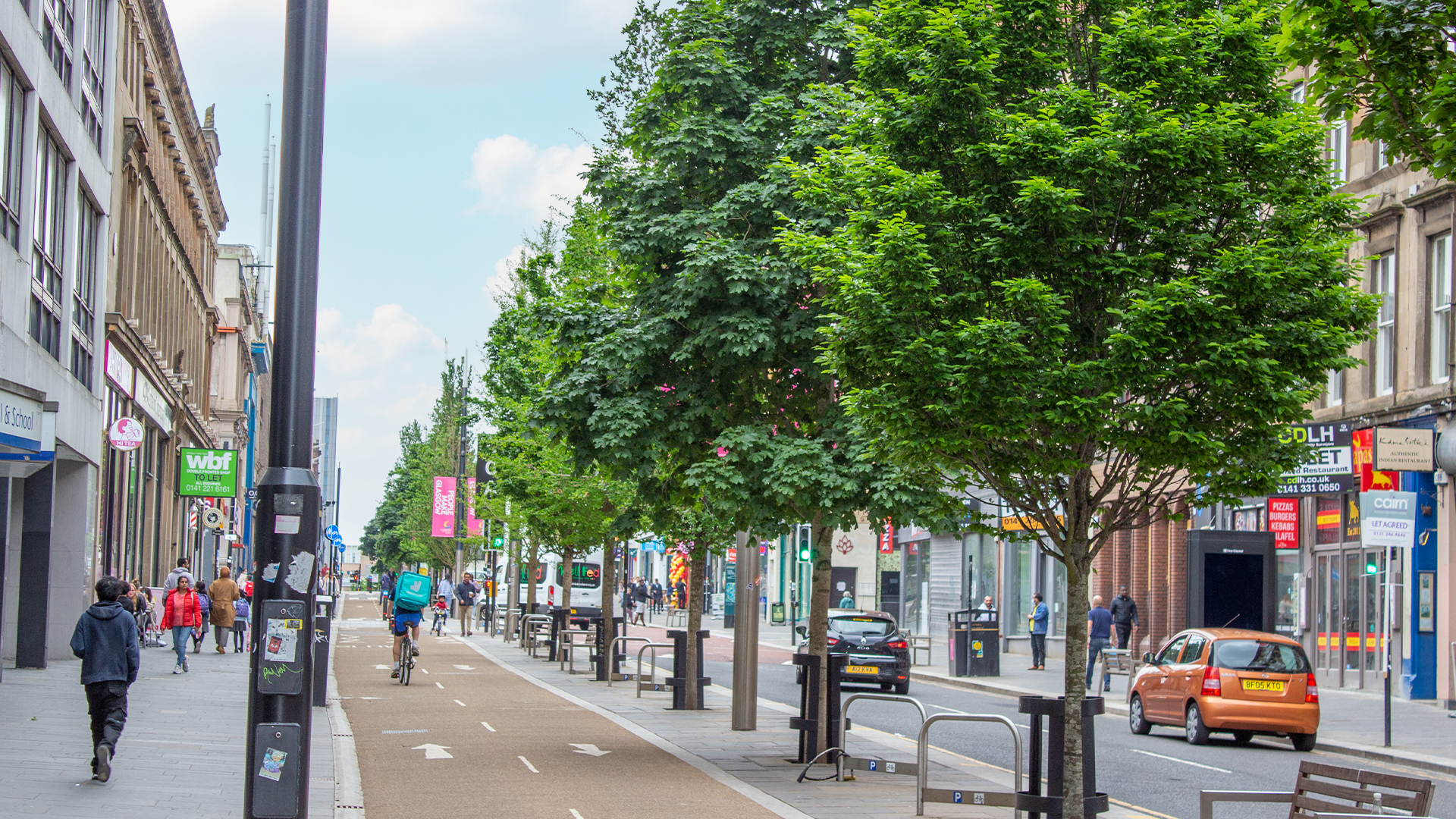Clean Air Day, the UK’s largest campaign on air pollution, is taking place on Thursday 15th June 2023. This article marks the occasion by focusing on links between air quality and green infrastructure.
The largest source of unclean air in the UK is the transport sector, with the highest levels of pollutants found alongside busy roads. To tackle this issue, the government’s 2019 Clean Air Strategy identifies
“intelligent tree planting and better access to green infrastructure”
as part of a mix of actions required to be pursued, with tree planting acknowledged alongside other measures such as promoting active travel, public transport, and zero and ultra-low vehicles.
This suggests that green infrastructure has a role to play in improving air quality. Indeed, the avoided mortality and morbidity due to air pollution removal by UK urban green and blue space were quantified by the Office for National Statistics, estimating the economic value arising from these avoided health costs in 2015 alone equalled £136m.
But what does “intelligent tree planting” look like to improve air quality?
Creating cleaner air oases using green infrastructure
Polluted air alongside busy roads is not only a very hostile environment for people, impacting negatively on their health. It is also damaging to green infrastructure including trees and hedges. This means the decisions made early at the design stage will determine whether we end up with, quoting Ferranti et al. (2019), “relatively cleaner ‘oases’” or “relatively dirtier ‘hotspots’”.

Trees are not inert assets such as lamp posts or other grey infrastructure. They are living breathing things – “fluid entities”, quoting Barwise and Kumar (2020), responsive to the environment they are in. Well-informed and carefully considered tree species selection is critical for ensuring that any trees planted to act as a vegetation barrier will thrive. Furthermore, over their lifespan, the trees will deliver desired benefits such as shade and temperature regulation whilst being resilient to withstanding pests and climate change.
The best practice guidance on the topic was brought together by Kumar et al. (2019). It offers design suggestions of what and where to plant depending on the type of road environment and offers a list of 19 tree species considered suitable for air pollution abatement either as trees or hedges.
Barwise and Kumar (2020) expand on this work, producing a more comprehensive initial list of viable tree species for the UK to act as vegetation barriers, by drawing on the earlier tree species selection tool by Hirons and Sjöman.
The list brings together data for 61 tree species and their key traits such as canopy density, leaf surface area, and drought tolerance. It also takes into account disbenefits in the form of pollen and naturally volatile organic compounds produced by trees.
To help further guide a selection process of green infrastructure for improved air quality, Barwise and Kumar (2020, p. 15) suggest that practitioners ask these four questions:
- Will the species thrive under the given environmental conditions?
- Do the known ecophysiological and morphological characteristics of the species complement the conditions of the urban context (street canyon or open road)?
- Will the species contribute minimal emissions?
- Does the species bear traits that are deemed to be beneficial for pollution abatement?
An online tool to design your own hedge that takes into account different types of road environments was developed by Barwise et al. (2021). The authors tested the tool prototype with members of the public, with plans for future versions aimed at green infrastructure practitioners as its users.
| Atmospheric dispersion: comprising “the transportation and dilution of pollutants from the pollutant source, and the various roles that vegetation may play” |
| Dry deposition: “ describes the process by which pollutants are deposited on solid surfaces, thereby reducing ambient atmospheric concentrations” |
Table 1 Definitions of the two mechanisms for green infrastructure to tackle air pollution. Source: Barwise and Kumar (2020, p.6):
Minimising pedestrian exposure to air pollutants using green infrastructure: does it work?
Overall, the air quality and green infrastructure dynamics are complex, with different elements not easy to untangle and control (e.g., Barwise and Kumar, 2020, Ferranti et al. 2019, Kumar et. al, 2019). In urban areas, the impact of green infrastructure including trees on cleaning the air is unfortunately minimal. This is unless it is strategically placed to act as a barrier that modifies wind flow, re-directing pollutants away from pedestrians and other users (Ferranti, MacKenzie, and Levine, 2019).
For example, with regards to tackling urban pollution caused by nitrogen dioxide (NO2), one of the pollutants for which the UK experiences enduring breaches of legal limits, the Air Quality Expert Group concluded in its 2018 report that using green infrastructure was, in general, futile due to its failure to act as a good sink for this particular pollutant.
Policy-wise, the 2018 report by the Air Quality Expert Group suggests devising an
“integrated policy which separates people spatially from major pollution sources (especially traffic) as far as possible and in which vegetation is used between the sources and the urban population maximises its beneficial effects.”
Consequently, there is not a one size fits all approach, continue Barwise and Kumar (2020): instead, the design and choice of green infrastructure for vegetation barrier purposes are context-driven, with some local environments more suited to act as effective pollutant sinks than others. Different types of urban environments will require different solutions, such as an open-road environment versus one comprising a street canyon – reviewed in detail by Abhijith et al. (2017).
Barwise and Kumar (2020) conclude that green infrastructure is an effective solution for tackling air pollution that works at a local level, but not necessarily at a larger scale, e.g., in a town or city. On p. 12 of their review, the authors offer these recommendations:
- Green infrastructure can be utilised to reduce pollution exposure at the local scale, but active control (reduced emissions) is the most effective strategy across scales.
- City-scale analyses of interactions between green infrastructure and air quality may generate inappropriate planting recommendations, with limitations in down-scaling due to extreme heterogeneity in local-scale conditions and inherent context-dependency in the influences of different.
A similar conclusion was arrived at in the 2018 report by the Air Quality Expert Group. The report by an expert committee of the Department for Environment, Food and Rural Affairs (Defra) examined the relationship between air quality and green infrastructure. Challenging what the groups call “the campaigning zeal for vegetation”, the report observes on p. 6: “Overall, vegetation and trees, in particular, are regarded as beneficial for air quality, but they are not a solution to the air quality problems at a city scale.”
In summary, green infrastructure has a role to play but it is not a panacea when it comes to eradicating air pollution. Instead, we must focus on removing the source of pollution as the real solution for improving air quality and that means reducing road transport and other emissions (e.g., Ferranti, MacKenzie, and Levine 2019).
How big is the air pollution issue?
Clean Air Day offers a chance to find out and share more about this important issue and how it can be addressed. Learn more about air pollution here.
The day serves as a principal reminder that air pollution remains one of the biggest environmental threats to human health.
Globally, based on 2019 data by the World Health Organisation, outdoor air pollution is estimated to be behind 4.2 million premature deaths worldwide, whilst 99% of the world’s population was living in places where the air quality guidelines levels were not met.
Across the UK, 24 million people are exposed to polluted air and over 40,000 early deaths per year are attributed to air pollution, according to a report by Asthma + Lung UK and Impact on Urban Health.
Clean air is one of the goals set within the government’s 25-year Environment Plan and the subsequent Environmental Improvement Plan published earlier this year.

Sauchiehall Street – Glasgow, Scotland
A pilot place-making scheme: an example of successful urban retrofit using green infrastructure combined with active travel components. The tree planting scheme, comprising 28 tree species, newly provides a strong visual segregation between vehicles and pedestrians and cyclists, as well as helping to reduce pedestrian exposure to air pollutants.
Enabling healthier urban environments for all.

Acknowledgements:
GreenBlue Urban is very grateful for the following reviewers of the draft article:
Prashant Kumar, Professor & Chair in Air Quality and Health at the University of Surrey.
Professor Kumar is the Founding Director of the Global Centre for Clean Air Research (GCARE), the founding Co-Director of the pan-University Institute for Sustainability, and the Principal Investigator and Director of the RECLAIM Network Plus.
The RECLAIM (Reclaiming Forgotten Cities – Turning Cities from vulnerable spaces to healthy places for People) Network is funded by several cross-disciplinary research councils (AHRC, NERC, UKRI, EPSR). It brings together researchers from four universities and one institute. It aims to create a blue-green infrastructure community of practice whilst examining knowledge gaps around blue-green infrastructure effectiveness. GreenBlue Urban is a member of the RECLAIM network.
Sue James AA Dipl RIBA FICFor (Hon), convenor of the TDAG network, and Dr Emma Ferranti, Associate Professor at the Department of Civil Engineering at the University of Birmingham, who co-facilitates the TDAG network. TDAG stands for The Trees and Design Action Group. As a network, it facilitates cross-sector & cross-disciplinary dialogue and projects promoting the role of urban trees. GreenBlue Urban is a supporter of the TDAG network.
Samuel Rouse MSc, Senior Air Quality Officer at Brighton & Hove City Council, acted as the author’s sounding board: offering a practitioner’s perspective, providing useful comments on an initial idea for this article, and recommending some of the references listed.
Author: Dr Kristina Sodomkova, consultant at GreenBlue Urban, a blue-green infrastructure solutions manufacturer, and provider based in East Sussex.
GreenBlue Urban is a supporter of the Clean Air Day campaign

